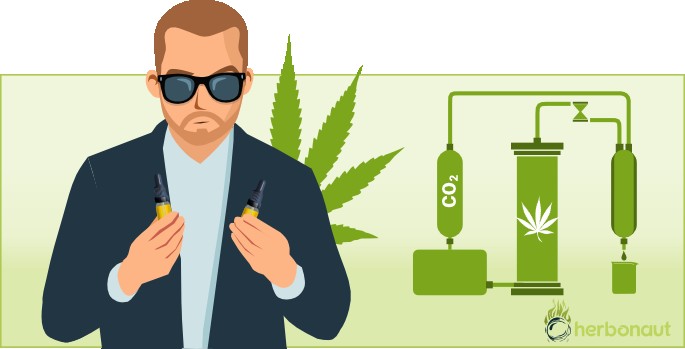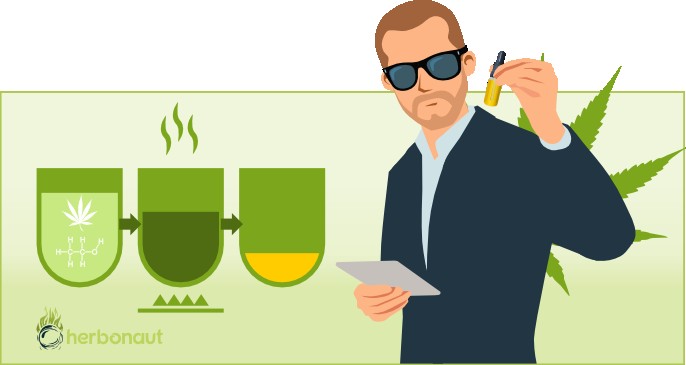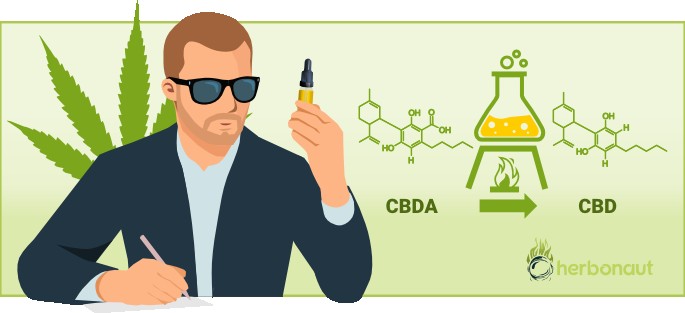
CBD brands sometimes use extraction methods as a unique selling point.
Browsing their websites, you might find statements similar to:
Our CBD Oil is CO2-extracted and leaves behind no toxins!
Or
Our CBD oil is food-grade ethanol extracted and is truly full spectrum!
But what difference is there exactly between all these extraction methods? And how do these differences matter for you, the consumer?
Keep reading to learn more!
The Different CBD Extraction Methods
While there are many different ways of extracting compounds out of cannabis plants …
There are only two types of CBD extraction methods that can be scaled to the output that commercial companies need:
- CO2-extraction, and;
- Volatile organic compound (VOC) solvent-based extraction.
Let’s dive a bit deeper into these methods.
CO2 Extraction of CBD
Supercritical/subcritical CO2 extraction refers to an extraction method that makes use of carbon dioxide and the manipulation of temperatures and pressure.
Supercritical CO2-extraction is the most used CBD-extraction method. In this method, carbon dioxide is pressurized until a point where the CO2 molecules reach a ‘supercritical’ state. A supercritical state means a state where the compound has properties of both liquid and gas.
In this supercritical state, the carbon dioxide molecules are quite effective at stripping compounds like cannabinoids from cannabis plants.
It’s a very clean and non-toxic method because CO2 itself is clean and non-toxic. That’s also the biggest benefit of CO2 extraction: you can be sure that no residual solvents are left inside your end-product, without any test results showing you that.
Although CO2 extraction is very clean and non-toxic, it’s not the best method to extract especially terpenes from cannabis plants.
Although there are CBD oil producers that make it work, to produce a full-spectrum CBD oil, supercritical CO2 extraction isn’t the best extraction method. And the main reason for this is the following:
A full-spectrum CBD oil is only truly ‘full-spectrum’ if it contains a wide variety of terpenes in high concentrations.
With this method, you won’t be able to extract especially a full range of terpenes in high concentrations. Terpenes are highly volatile compounds and evaporate quickly under pressure or high temperature. High pressure is exactly what you get in this method.
For any other type of CBD oil, whether that’s a broad-spectrum and doesn’t contain a full spectrum of terpenes or a purified CBD product like CBD Isolate, supercritical CO2 extraction generally works fine.
Now:
‘Subcritical’ CO2 extraction is more effective in extracting volatile compounds like terpenes from cannabis plants than its supercritical brother. In this method, carbon dioxide is less pressurized and heated. This results in better retention of volatile compounds like terpenes.
This method, however, isn’t used often by producers because it’s less efficient and produces less yield.
One brand that makes use of subcritical CO2-extraction is NuLeaf Naturals.
Both supercritical and subritical CO2-extraction are non-toxic and green methods of extraction.
However:
The methods that extract terpenes and cannabinoids in the most efficient and effective way (the full spectrum of them and in high amounts) are solvent-based extractions.
Volatile Organic Compound Solvent-Based CBD Extraction

Volatile Organic Compound (VOC) solvent-based extraction refers to extracting the goods out of the cannabis with the use of organic solvents like:
- Butane;
- Propane, or;
- Ethanol.
Generally, VOC-solvent-based extractions are most effective in extracting both cannabinoids and terpenes from cannabis plants.
And while butane and propane are extremely effective in stripping the hemp plant of its most essential compounds like cannabinoids and terpenes, these solvents aren’t interesting to most large-scale manufacturers.
Here’s why:
Propane- and butane-based solvent extraction is difficult to scale. Therefore, you won’t find many butane- or propane-extracted CBD products being commercially sold.
That leaves us with ethanol-based extraction. Ethanol is like butane and propane very effective in extracting cannabinoids and terpenes. In fact, one study published in the Journal of Pharmaceutical and Biomedical Analysis (1) found that ethanol-extraction at room temperature was the most effective method in cannabinoid-retention compared to the methods that fall under supercritical fluid extraction (like CO2-extraction).
But there’s a catch:
Because ethanol is an extremely polar solvent, it’s also highly effective in extracting other ‘unwanted’ compounds from the hemp plant, like waxes, lipids, and chlorophylls. This means that ethanol-based hemp extractions often undergo a more extensive filtering process to:
- Remove these unwanted compounds like waxes, lipids, and chlorophylls, and;
- Because ethanol has a relatively high boiling point, remove the ethanol itself from the end-product.
Now:
If in this filtering process any cannabinoids or terpenes get permanently removed, it ceases to be a full spectrum product and becomes a broad-spectrum product.
Also, important to mention is that for a true full-spectrum CBD product to stay full spectrum, it can’t be heated at high temperatures and/or for long periods of time.
Here’s why:
Terpenes are highly volatile compounds, and easily evaporate when heated. When you lose the terpenes, the product ceases to be a full spectrum product. Terpenes are essential to full-spectrum CBD products.
This brings us to the next point…
Decarboxylation of CBD

Cannabinoids like CBD can be found in raw and fresh Hemp, largely in their acidic form. In the case of CBD, its acidic form is called CBDA. CBDA becomes CBD when it undergoes a process of decarboxylation. The decarboxylation process already starts at room temperature, but processes at a very slow speed at this temperature. To speed up the decarboxylation process, you need to heat up the CBDA.
By why would you want to decarboxylate the CBDA in the first place? Well, 95% of research in the past decades has focused on CBD and found many potential benefits related to CBD and not necessarily CBDA.
Does this mean that CBDA doesn’t have any benefits?
Not at all. In fact, more and more research is showing that CBDA could have even more potent benefits than CBD itself. But research on CBDA is new and rare, and especially human studies are extremely rare. What this means is that most CBD manufacturers decarboxylate their CBDA by heating it.
Now, depending on the temperatures and timestamps CBD manufacturers use to decarboxylate the CBDA to CBD in their raw Hemp extracts, it could mean that during the decarboxylation process significant concentrations of terpenes evaporate.
This, in turn, means that true full-spectrum products, can’t have undergone a decarboxylation process involving high temperatures…unless the manufacturer captured these evaporated terpenes through condensation and re-introduced them into the final product.
How can you know if your ‘full spectrum’ oil truly contains the full spectrum of cannabinoids and terpenes of a high-resin Hemp plant? Well, either:
- You fully know and understand the implications of the manufacturing process of your CBD oil provider, or;
- You have a clear lab-test report showing you cannabinoid and terpene-profiles and contents.
Just realize that these lab-test reports usually don’t show all terpenes and cannabinoids, but they can give you a good indication of the product’s cannabinoid- and terpene-profile.
Unheated CBD vs. Heated CBD
A study that looked at peak plasma concentrations of CBD in a comparison of capsules filled with either unheated or heated cannabis extracts containing 10 mg THCtotal (THC + THCA) and 10–15 mg CBDtotal (CBD +CBDA), found that peak plasma CBD concentrations were 4 times higher in the unheated extract (2)!
The unheated CBD extract contained:
- A much higher concentration of CBDA than the heated CBD-extract, and;
- A lower CBD concentration than the heated CBD-extract.
Further research should confirm these results, but based on this study we can conclude that you would benefit from having a high concentration of CBDA in your CBD product as well.
And the only way to keep a high concentration of CBDA in your CBD product is by not processing with high temperatures that transform the CBDA into CBD.
Learn More
The Best CBD Oils: A list of our recommended CBD oils, includes full-spectrum, broad-spectrum, and CBD isolates. All are 3th-party lab-tested to confirm they’re contaminant-free and contain high levels of CBD.
The Cheapest CBD Oils, Gummies, and Softgels: The most affordable products that are still of high-quality.
The Best CBD Gummies: A list of our recommended CBD gummies. All are 3th-party lab-tested to confirm they’re contaminant-free and contain high levels of CBD.
The Best CBD Vape Oils: A list of our recommended CBD vape oils. All are 3th-party lab-tested to confirm they’re contaminant-free and contain high levels of CBD.
The Benefits of CBD Oil: A review of over 100 studies that found potential health benefits associated with CBD.
How to Use CBD Products: A review of over 40 studies that (among other things) looked at the effects and potency of CBD based on methods of use.
Scientific References:
-
Brighenti, V., Pellati, F., Steinbach, M., Maran, D., & Benvenuti, S. (2017). Development of a new extraction technique and HPLC method for the analysis of non-psychoactive cannabinoids in fibre-type Cannabis sativa L. (hemp). Journal of Pharmaceutical and Biomedical Analysis, 143, 228–236. https://doi.org/10.1016/j.jpba.2017.05.049
-
Eichler, M., Spinedi, L., Unfer-Grauwiler, S., Bodmer, M., Surber, C., Luedi, M., & Drewe, J. (2012). Heat Exposure ofCannabis sativaExtracts Affects the Pharmacokinetic and Metabolic Profile in Healthy Male Subjects. Planta Medica, 78(07), 686–691. https://doi.org/10.1055/s-0031-1298334